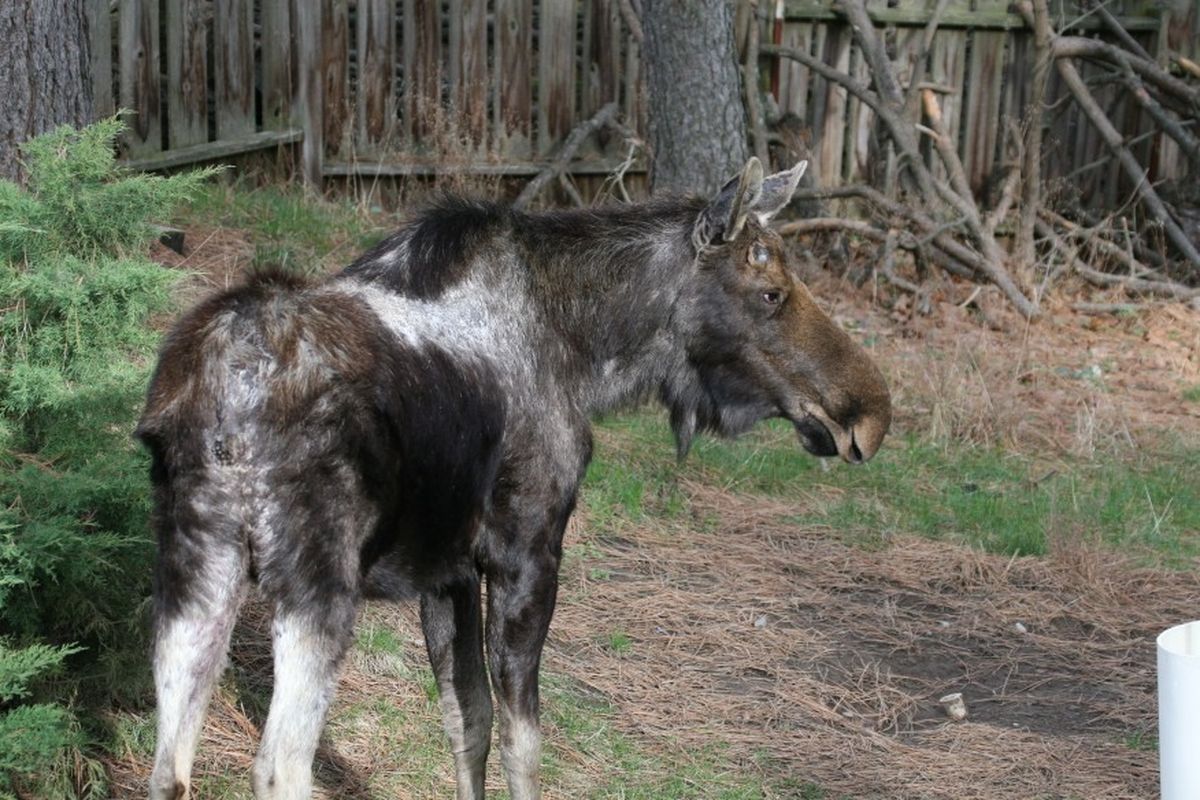Ghost-like moose proof that ticks suck
A bull moose yet to begin sprouting new antlers was photographed on on March 21, 2013, in the Ponderosa neighborhood of Spokane Valley by Hans Krauss. The moose's condition indicates it's been infested with ticks. (Hans Krauss)
The graying look of moose you might see in the field this spring isn’t the result of old age.
It’s likely the work of blood-sucking ticks.
The Coeur d’Alene office of the Idaho Department of Fish and Game has received several calls recently from wildlife watchers concerned about odd-looking moose around towns as well as in wild places.
“The moose appear to be partially white, or, as one caller described, ‘ghost-like’ in appearance,” said Phil Cooper, department conservation educator.
“Moose can experience tick infestations that start in mid-September but the problem is not clearly visible to people until late in the following winter.
The ticks are called “moose ticks” or “winter ticks.” They are not attracted to humans.
“The infestations become visible when moose scratch and paw at their own skin enough to cause large patches of hair to break or fall out,” Cooper said. “That is when IDFG begins to get reports of sick-looking moose.
“Many times these patches are on the withers where moose are able to reach and scratch with their hooves. The skin exposed by the hair loss is light colored and from a distance the exposed skin makes the moose appear to be white in color.
Last winter, Hans Krauss, a Spokane Valley wildlife enthusiast and photographer, shot photos of a bull moose in the Ponderosa neighborhood.
What first caught his eye are the bases of where antlers had fallen off, and where the new antler growth soon will be sprouting.
Then he realized, “That poor bugger is infested with ticks.”
The grayish look and the hair rubbed off in patches including the ears were obvious clues while the engorged ticks on the moose’s rump were graphic.
Krauss’s photo was forwarded to Kristen Mansfield, the state’s wildlife veterinarian with the questions: “I wonder if this amount of grey color is shedding, old age, ticks, normal end of winter condition, or other?
Mansfield said, “The whitish-grayish coloring of the legs is normal.
“The thin hair and whitish-grayish coloring in the saddle area, neck, and rump are where he’s been scratching at winter ticks. You can even see several ticks in his perineal area.
“He does look thin, but not really emaciated to me. Kind of what I’d expect this time of year in an animal that appears to have had a miserable winter dealing with lots of ticks.”
Moose tick larvae hatch from eggs and lay on the ground in April, and climb vegetation during the late summer and early fall, Cooper explained.
This is where the story gets creepy. They don’t get themselves in position to infest moose one at a time. Rather, they gang up.
Stimulated by the carbon dioxide exhaled by a moose, the ticks interlock their legs and wait.
“When a moose contacts the brushy vegetation covered by interlocked tick larvae, strings of thousands of tick larvae cling onto the hair of the moose and crawl toward the skin,” Cooper said.
“These tick larvae can also cling to deer; however, deer appear to be able to scratch them off.”
Moose are a giant free buffet to these specialized arachnids. For example, researchers investigating a moose carcass documented more than 100,000 ticks.
“Moose ticks take a blood meal from their host in November, January, March and April to mature from larvae to adults,” Cooper said. ”In April, the adult female ticks drop off to lay their eggs on the soil surface, starting the tick life cycle over again.”
Wildlife biologists already know that thousands of feeding ticks are potentially fatal to a moose. While some moose survive until the ticks fall off, some moose die.
“The cause of mortality can be loss of blood, hypothermia due to loss of hair, or starvation when the severe itching causes them to forage less than is necessary to maintain themselves,” Cooper said.
Studies in several states, including Minnesota and Montana, are looking into tick infestations as one of several possibilities for general declines in moose populations.
“Mortality is highest in calf moose,” Cooper said. “Their smaller body mass loses heat more readily and is more vulnerable to blood loss. A National Geographic video program on moose ticks reports that calves can potentially lose half of their blood to the attached ticks.”
By late May, the moose are mostly tick-free and they begin to recover their normal look before facing the possibility of a new infestation in the fall.

